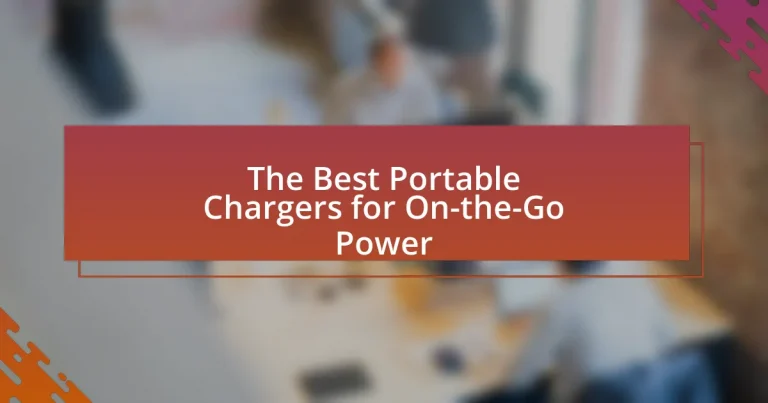Portable chargers, also known as power banks, are essential devices that provide on-the-go power for smartphones, tablets, and laptops, especially when access to traditional power sources is limited. This article explores the functionality, key components, and benefits of portable chargers, emphasizing their importance in enhancing mobility and connectivity for users. It also discusses critical features to consider when selecting a portable charger, such as battery capacity, charging speed, and safety mechanisms. Additionally, the article reviews top portable charger brands and models, offering insights into their performance and suitability for various user needs, including travel and heavy smartphone usage.

What are Portable Chargers and Why are They Important?
Portable chargers, also known as power banks, are external battery packs designed to recharge electronic devices such as smartphones, tablets, and laptops when access to a power outlet is unavailable. They are important because they provide a convenient solution for maintaining device functionality during travel, outdoor activities, or emergencies, ensuring that users can stay connected and productive. According to a study by Statista, the global portable charger market was valued at approximately $9.5 billion in 2020 and is projected to grow, highlighting the increasing reliance on mobile devices and the need for on-the-go power solutions.
How do Portable Chargers Work?
Portable chargers work by storing electrical energy in a built-in battery, which can then be used to recharge devices like smartphones and tablets. These chargers typically contain lithium-ion or lithium-polymer batteries that convert and store electrical energy from a power source, such as a wall outlet or USB port. When a device is connected to the portable charger, the stored energy is transferred to the device’s battery through a USB cable, allowing it to recharge. The efficiency of this energy transfer can vary, but most portable chargers are designed to provide a reliable source of power for on-the-go use, making them essential for users who need to keep their devices charged while away from traditional power sources.
What are the key components of a Portable Charger?
The key components of a portable charger include the battery, charging ports, and circuitry. The battery, typically lithium-ion or lithium-polymer, stores electrical energy for later use, providing the primary power source. Charging ports, such as USB-A, USB-C, or micro-USB, allow devices to connect and receive power. Circuitry manages the flow of electricity, ensuring safe charging and preventing overcharging or overheating. These components work together to deliver efficient and reliable power to devices while on the go.
How does battery capacity affect charging performance?
Battery capacity directly influences charging performance by determining how much energy a battery can store and deliver. A higher capacity battery can hold more charge, allowing it to power devices for longer periods and support faster charging rates. For instance, batteries with a capacity of 20,000 mAh can typically charge devices multiple times before needing a recharge themselves, while lower capacity batteries, such as those with 5,000 mAh, may only provide a single charge. This relationship is supported by the fact that charging speed is often limited by the battery’s capacity; larger batteries can handle higher wattage inputs, resulting in quicker charging times.
What Benefits Do Portable Chargers Provide?
Portable chargers provide the benefit of convenient, on-the-go power for electronic devices. They enable users to charge smartphones, tablets, and other gadgets without needing a wall outlet, making them essential for travel, outdoor activities, or emergencies. According to a survey by Statista, 67% of smartphone users reported that battery life is a critical factor in their device usage, highlighting the importance of portable chargers in extending device usability.
How do Portable Chargers enhance mobility for users?
Portable chargers enhance mobility for users by providing a convenient and reliable source of power for electronic devices while on the move. This capability allows individuals to charge smartphones, tablets, and other gadgets without being tethered to a wall outlet, thus facilitating uninterrupted connectivity and productivity. According to a survey by the Pew Research Center, 95% of Americans own a cellphone, and the ability to charge these devices on-the-go is essential for maintaining communication and access to information in various situations, such as travel or outdoor activities.
What are the advantages of using Portable Chargers over traditional power sources?
Portable chargers offer significant advantages over traditional power sources, primarily in their convenience and portability. Unlike traditional power sources, which require a fixed outlet, portable chargers allow users to charge devices anywhere, making them ideal for travel, outdoor activities, or emergencies. Additionally, portable chargers often have built-in safety features such as overcharge protection and short-circuit prevention, enhancing user safety compared to some traditional power sources that may lack these features. Furthermore, many portable chargers are designed to be lightweight and compact, making them easy to carry without adding bulk, which is not the case with most traditional power sources.

What Features Should You Look for in a Portable Charger?
When selecting a portable charger, prioritize features such as battery capacity, output power, size and weight, charging speed, and safety features. Battery capacity, measured in milliampere-hours (mAh), determines how much charge the device can hold; for example, a 10,000mAh charger can typically charge a smartphone two to three times. Output power, indicated in watts, affects how quickly devices charge; chargers with higher output (like 18W or more) support fast charging. Size and weight are crucial for portability; a compact and lightweight charger is easier to carry. Charging speed is enhanced by technologies like Quick Charge or Power Delivery, which significantly reduce charging time. Lastly, safety features such as overcharge protection and short-circuit prevention ensure the safety of both the charger and the devices being charged.
How do Different Charging Speeds Impact User Experience?
Different charging speeds significantly impact user experience by influencing the convenience and efficiency of device usage. Faster charging speeds reduce downtime, allowing users to quickly recharge their devices and continue using them without prolonged interruptions. For instance, a study by the International Journal of Electrical Engineering Education found that devices charged at 18W can reach 50% battery in approximately 30 minutes, compared to 5W chargers that may take over two hours for the same charge. This efficiency enhances user satisfaction, particularly for those who rely on their devices for work or communication while on the go. Additionally, faster charging speeds can improve the overall perception of a product’s quality, as users often associate quick charging capabilities with advanced technology and better performance.
What is the significance of fast charging technology?
Fast charging technology significantly reduces the time required to charge electronic devices, enhancing user convenience and efficiency. This technology allows devices to reach substantial battery levels in a fraction of the time compared to standard charging methods; for instance, some fast chargers can provide up to 50% battery in just 30 minutes. The widespread adoption of fast charging is driven by the increasing demand for quick power solutions in a fast-paced lifestyle, particularly for smartphones and laptops, where users often need rapid recharges during busy days.
How do charging ports and compatibility affect usability?
Charging ports and compatibility significantly affect usability by determining the ease with which devices can be charged. When a portable charger has multiple charging ports that support various standards, such as USB-C, Lightning, and Micro-USB, it enhances usability by allowing users to charge different devices without needing multiple cables. For instance, a study by the International Telecommunication Union found that universal charging solutions can reduce electronic waste and improve user convenience. Therefore, compatibility with widely used charging standards directly influences the effectiveness and user satisfaction of portable chargers.
What Safety Features are Essential in Portable Chargers?
Essential safety features in portable chargers include overcharge protection, short circuit protection, temperature control, and surge protection. Overcharge protection prevents the battery from being charged beyond its capacity, which can lead to overheating and potential damage. Short circuit protection safeguards against electrical faults that could cause fires or damage to devices. Temperature control mechanisms monitor the charger’s heat levels, ensuring it operates within safe limits to prevent overheating. Surge protection guards against voltage spikes that can harm both the charger and connected devices. These features are critical for ensuring user safety and device longevity, as evidenced by industry standards and safety certifications that portable chargers must meet to be deemed reliable.
How do overcharge protection and temperature control work?
Overcharge protection prevents battery damage by stopping the charging process once the battery reaches its full capacity, typically using a battery management system (BMS) that monitors voltage levels. This system ensures that excess voltage does not enter the battery, which can lead to overheating, swelling, or even explosions. Temperature control works by monitoring the battery’s temperature during charging and discharging; if the temperature exceeds safe limits, the system reduces or halts the charging current to prevent thermal runaway, a condition that can cause fires or battery failure. These mechanisms are essential for maintaining battery health and safety in portable chargers, which often utilize lithium-ion technology known for its sensitivity to overcharging and temperature fluctuations.
Why is it important to have short-circuit protection?
Short-circuit protection is crucial because it prevents damage to electrical devices and reduces the risk of fire hazards. When a short circuit occurs, excessive current flows through the circuit, which can lead to overheating and potential failure of components. According to the National Fire Protection Association, electrical failures, including short circuits, are a leading cause of residential fires. Implementing short-circuit protection in portable chargers ensures user safety and device longevity by automatically disconnecting the power supply during such events.

What are the Top Portable Chargers Available Today?
The top portable chargers available today include the Anker PowerCore 20100, RAVPower 26800, and Aukey 20000. The Anker PowerCore 20100 is renowned for its high capacity and fast charging capabilities, featuring PowerIQ technology that optimizes charging speed for various devices. RAVPower 26800 stands out with its massive capacity and multiple output ports, allowing simultaneous charging of multiple devices. Aukey 20000 is noted for its compact design and Quick Charge 3.0 support, making it efficient for quick power boosts. These chargers are highly rated for their reliability and performance, making them ideal for on-the-go power needs.
How do Popular Brands Compare in Performance?
Popular brands of portable chargers, such as Anker, RAVPower, and Aukey, generally exhibit superior performance characterized by high capacity, fast charging capabilities, and reliability. Anker, for instance, is known for its PowerIQ technology, which optimizes charging speed, achieving up to 2.4A per port, while RAVPower offers models with capacities exceeding 26,000mAh, allowing for multiple device charges. Aukey also provides competitive options with Quick Charge technology, enabling devices to charge up to 75% faster than conventional methods. These brands consistently receive high ratings in consumer reviews and performance tests, validating their standing in the market for portable chargers.
What are the standout features of Brand A’s Portable Charger?
Brand A’s Portable Charger features high-capacity battery storage, rapid charging technology, and multiple output ports. The high-capacity battery allows for extended usage, typically providing several full charges for smartphones and tablets. Rapid charging technology enables devices to charge significantly faster than standard chargers, often achieving up to 50% charge in just 30 minutes. Additionally, multiple output ports facilitate charging of multiple devices simultaneously, enhancing convenience for users on the go.
How does Brand B’s pricing compare to its features?
Brand B’s pricing is competitive given its features, offering a balance of affordability and functionality. For instance, Brand B’s portable charger is priced at $30, while similar products with comparable features, such as fast charging and multiple ports, typically range from $25 to $40. This pricing strategy positions Brand B as a value option in the market, appealing to consumers seeking quality without overspending.
What are the Best Portable Chargers for Specific Needs?
The best portable chargers for specific needs include the Anker PowerCore 20100 for high-capacity charging, which offers 20,100mAh to charge devices multiple times. For fast charging, the RAVPower 26800mAh is ideal, featuring Quick Charge technology that can charge compatible devices up to 80% in 35 minutes. If lightweight portability is a priority, the Aukey 10000mAh is compact and easy to carry while still providing sufficient power for a smartphone. For outdoor activities, the Goal Zero Sherpa 100PD is a versatile option with solar charging capabilities and multiple output ports. Each of these chargers meets distinct user requirements, ensuring reliable power on the go.
Which Portable Chargers are best for travelers?
The best portable chargers for travelers include the Anker PowerCore 20100, RAVPower 26800, and Mophie Powerstation Plus XL. These chargers are highly rated for their capacity, portability, and fast charging capabilities. For instance, the Anker PowerCore 20100 offers a high capacity of 20,100mAh, allowing for multiple charges of smartphones and tablets, while the RAVPower 26800 provides even more power with its 26,800mAh capacity, making it suitable for longer trips. Mophie Powerstation Plus XL combines a sleek design with a built-in cable, enhancing convenience for travelers. These chargers are favored due to their reliability and efficiency, making them essential for on-the-go power needs.
What options are ideal for heavy smartphone users?
Ideal options for heavy smartphone users include high-capacity portable chargers, such as those with a capacity of 20,000 mAh or more, which can provide multiple full charges for smartphones. These chargers often feature fast charging technology, allowing users to quickly recharge their devices, which is essential for heavy usage. For instance, models like the Anker PowerCore 20100 and RAVPower 26800 are popular choices due to their reliability and efficiency, with the Anker model capable of charging an iPhone 8 up to seven times. Additionally, chargers with multiple USB ports enable simultaneous charging of multiple devices, catering to users who rely on several gadgets throughout the day.
What Tips Should You Follow for Choosing the Right Portable Charger?
To choose the right portable charger, prioritize capacity, compatibility, and charging speed. Capacity, measured in milliampere-hours (mAh), determines how much power the charger can store; for example, a 10,000 mAh charger can typically charge a smartphone two to three times. Compatibility with your devices is crucial; ensure the charger supports the voltage and amperage required by your devices, as mismatched specifications can lead to inefficient charging or damage. Additionally, consider the charging speed, which is influenced by the output power (measured in watts); chargers with higher output can charge devices faster, making them more convenient for on-the-go use.
How can you determine the right capacity for your needs?
To determine the right capacity for your needs, assess the total power consumption of your devices and the number of times you need to charge them. For example, if a smartphone has a battery capacity of 3000mAh and you plan to charge it twice, you would need a portable charger with at least 6000mAh capacity to ensure sufficient power. Additionally, consider the efficiency loss during charging, which typically ranges from 20% to 30%. Therefore, a portable charger with a capacity of around 8000mAh would be ideal for charging a 3000mAh device twice, accounting for efficiency losses.
What are the best practices for maintaining your Portable Charger?
To maintain your portable charger effectively, regularly check its battery health and avoid extreme temperatures. Keeping the charger in a cool, dry place prevents overheating and prolongs battery life. Additionally, charge the device periodically rather than letting it fully discharge, as lithium-ion batteries, commonly used in portable chargers, perform best when kept between 20% and 80% charge. Regularly clean the charging ports with a soft, dry cloth to prevent dust accumulation, which can hinder performance. Following these practices can enhance the longevity and efficiency of your portable charger.



